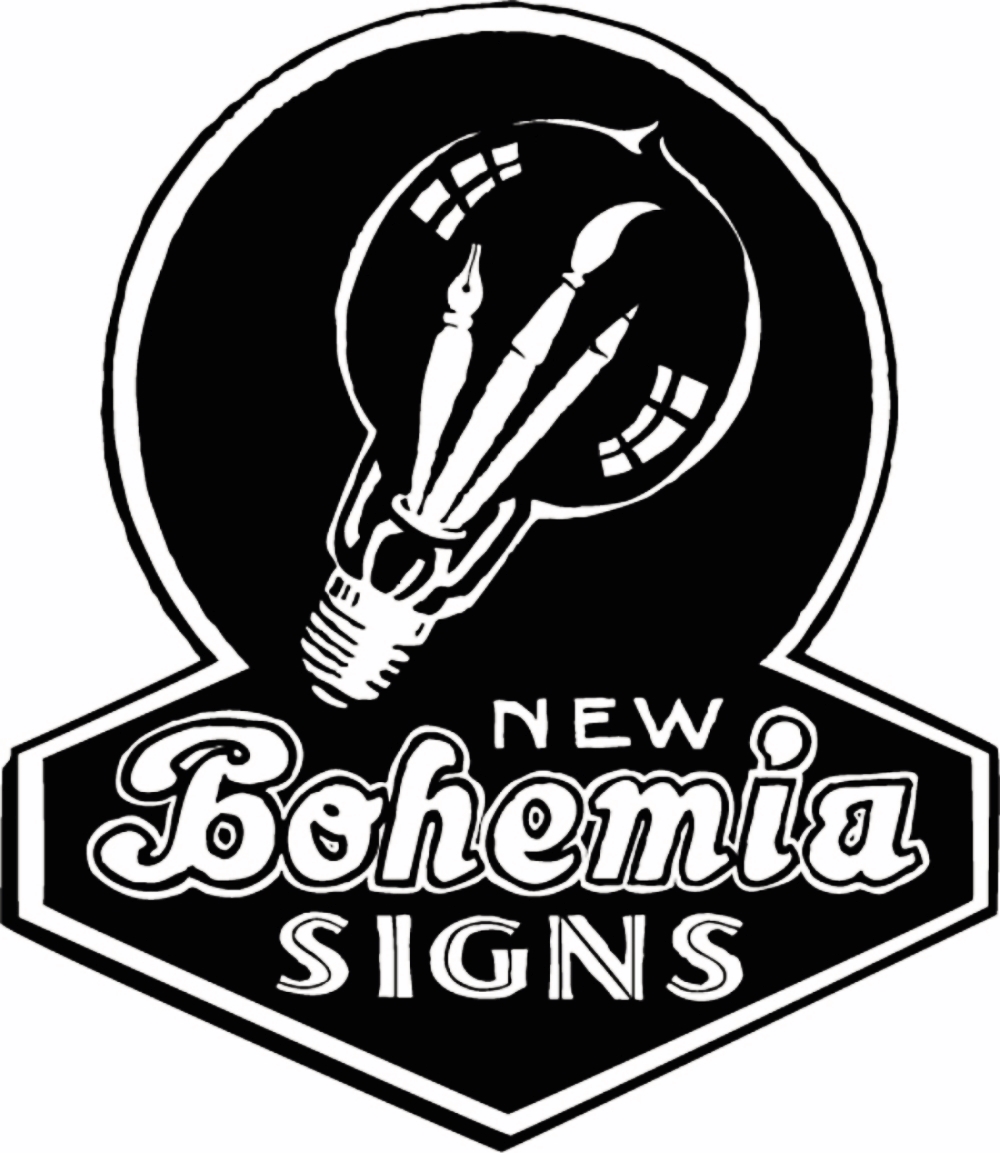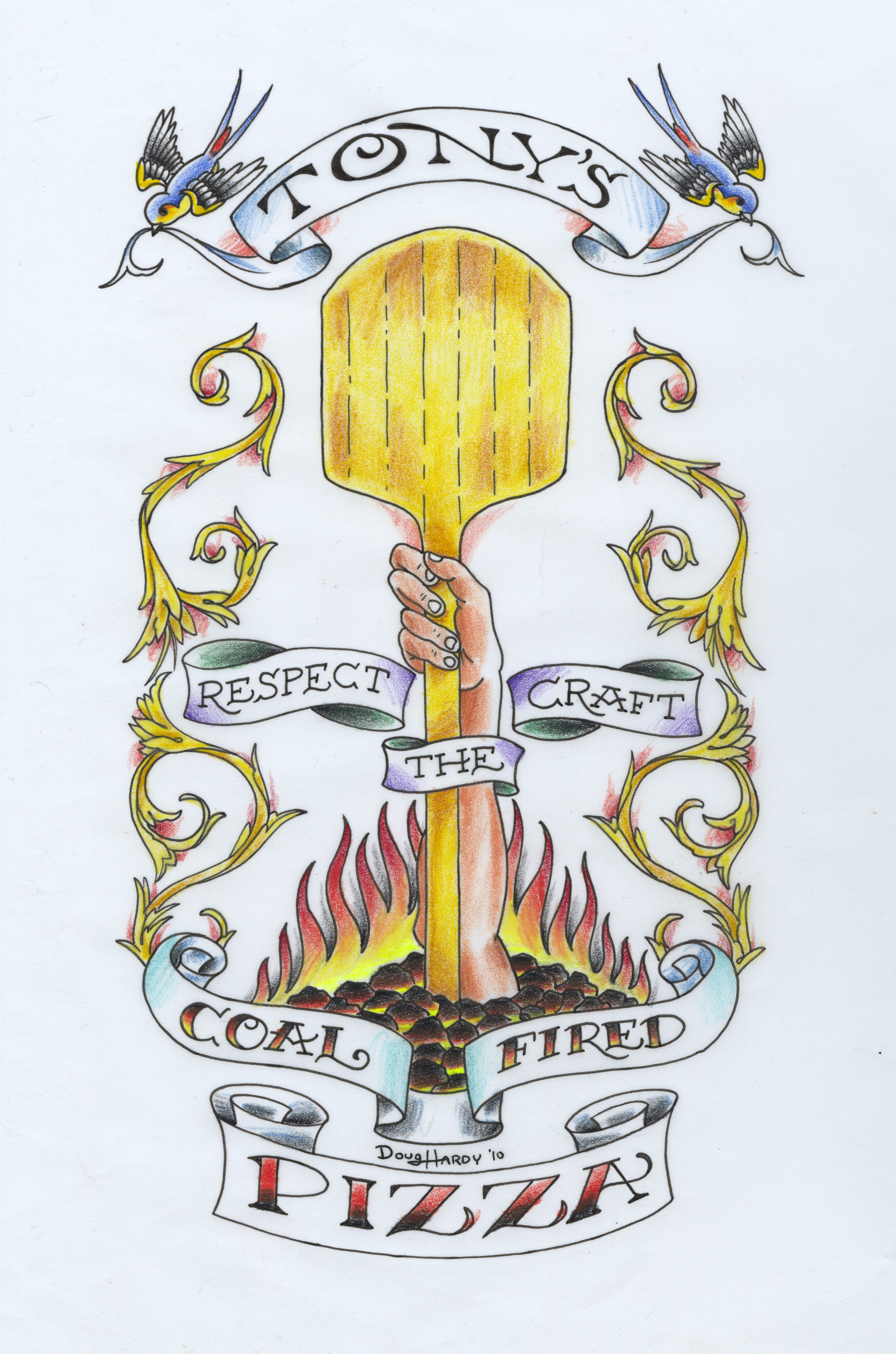Our networking maven, Rani, pointed me to an article in the Make blog, titled Lost Knowledge: Sign Painting. It does a pretty good job of encapsulating just where the trade stands right now. I find myself often saying to people who ask how business is doing, that it's "not exactly a growth industry" (for which I might submit my bank account as exhibit one). But I may have to reconsider my position: we're putting a little food on the table for a slowly widening coterie of folk, and there doesn't ever seem to be any waning of the number of people looking for apprenticeships and the like. Feels like there's a pretty solid base in place for sign painting in the coming decades, even if the bare-bones, journeyman-and-his-sign-kit aura of it does call to mind, perhaps appropriately, an earlier era of economic misery. It's been my experience that, while a lot of businesses are failing, other folk are getting pretty craftily entrepreneurial, and a lot of 'em need signs. Some of 'em make signs.
The Make article embeds a video about a recent ad campaign for Dewars, in New York, wherein Colossal Media painted a number of old-timey looking Shepard Fairey-designed billboards, that seemed to get a lot of people excited about reviving an ostensibly dying craft. While I was looking up the link to that John Downer video from my previous post, I found that Stephen had also, around the same time, sent me a link to this documentary about NYC billboard painters (here working on a Stella campaign):
[vimeo http://vimeo.com/10562000 w=600]
Watching these, I'm wondering if, in what I gather to be a rather long-established relationship between liquor, beer and sign writers, the patronage has somewhat reversed poles lately?
I took a bike ride 'round my neighborhood yesterday, surveying some recent additions to the painted billboard renaissance. First, on 18th and Valencia, something that I guess treads the line between billboard and "ad mural", for Pabst:

This isn't the first or only Pabst mural in town. Being primarily a painter-of-letters, the sloppy inscription on the can sticks in my craw, but I get that they're going for some sort of "socialist expressionism". Maybe it's in keeping with Levi's "we are all workers" party line, appealing to our fair city's leftist leanings... I wonder if Eric Herr painted the mural, and then Pabst hired a professional wall dog to climb up there and letter his byline.
This ad shares a wall with a number of other painted logos for the appliance retailer in the building behind it:

A couple blocks away, on 17th Street, at South Van Ness, is one of a few Hendrick's Gin billboards we've seen being painted recently:

Up close, this looks like it was done in 1Shot. The lettering is very adeptly realized, but looks more like the work of illustrators, than of letterers. Still, very handsome. I'd have been proud to have painted this, but I don't doubt I would have bid it out of the ballpark. I don't picture Bob Dewhurst taking on a job like this, and he's the only wall dog I know personally. I wonder what the billboard painters of today are getting paid.
(I have to admit here, I'm not especially well connected within the sign industry.)
The Hendricks board was painted on a building next door to a big mural for 7 Tepees youth center:

I didn't go looking for who painted the mural, but our whole neighborhood is pretty rich with mural work, which I s'pose makes it a pretty ripe proving ground for painted ads. Mural painting differs from billboard painting, at least in that it involves more charitable motives, and probably lower toxicity in the paint. I 'spect you can find, easily enough, some photo sets of SF murals online. You can book a tour, through Precita Eyes, who paint many of them, and from whom we buy graffiti coat for customers who demand it (in my experience, hand painted signs tend to attract much less graffiti than other signs--perhaps another reason for their recent uptick). But now, back to billboards.
Another block up 17th, on Folsom, I came across this:

I'm gonna guess this is a Sailor Jerry Rum ad, though it doesn't say anything about rum anywhere on it. I've seen smaller, printed wheat pasted ads around town, from the same campaign. I wonder if this is a kind of loss leader, where all the cheap paste-ups subsidize whatever they paid someone to paint this. Having just painted a tattoo flash art sign, I can only bow before the excellent blending job the painter here did with the enamels. If they were able to do this quickly enough to be affordable for everyone involved (such as is always the sign writer's concern: "always aspire to greater speed"), then bravo! This is a lovely piece of work.
I remember, years ago, biking past here and seeing the digipop people snapping a chalk line grid onto their wall, in which, over a couple of days, they painted individual radioactive-green blocks to form the letters of their name. Their space seems to be vacant now, but I trust their DIY spirit lives on!
Another brief diversion on my billboard tour: just to the right of Sailor Jerry, a poet has her own painted mini-billboard:

The tiny phone number at the bottom, which you can call, to hear the poet, is hand-lettered, but the text around the portrait is all vinyl letters stuck onto plexi. Shrug.
Now, way over on Potrero Hill, at the Anchor Brewery, is a beast of a very different stripe:

A ghost sign! You can even see the remnants of an older Anchor sign in the upper left!
That Make article, up top, has a few links to ghost sign collections. You can find some 12,000 shots in the Flickr Ghost Sign Group Pool. There's a lot of neat stuff in there I like to refer to. I really like this wall in Grafton, WV.
Except that this Anchor wall isn't a ghost sign at all: it's a big digital print. Bummer. Although, I do sorta like the way the pixelation mucks with one's spatial perception, up close (which may not translate well to web photo):

Anchor Brewing is a pretty big company, but I guess they're still in another, smaller league, from entities like Dewars, Pabst, and Stella (and maybe Hendrick's?)--the only corporate behemoths in a position to afford genuine hand painted signs... I think I'm speaking ironically, there. Actually, New Bohemia had done some work for Anchor in the past, before my time, but I've never gotten a call from them, myself. Somewhere, a bridge lay burned... Still, I'm a fan. I go to church across the street from here, at least in part because I love the smell of steaming barley mash on a Sunday morn.
Riding home from Anchor, I pass another kind of faux ghost sign:

For years, I thought this was just a disused billboard, tucked behind another, and not buffed out due merely to the charm of the little space man. Then, when I got to know Dewhurst, and realized that's his business name and number (since changed), in the lower right, I thought maybe he'd gotten permission to paint the billboard there as a clever ad for his own services. Turns out, he was hired to paint it there. The building owner just liked the look of that billboard, and had a place to put it. I'm lovin' it.
Every now and again, I have a customer who wants their sign "aged" in some way. I usually try to sell them on the idea that the design will evoke another era, and the sign itself will get old soon enough without me sanding it to bits. That said, I really enjoy when art comes up with new ways of getting us to ask "what's real?". We just saw Exit Through The Gift Shop the other day, so I'm high on that kind of thing.
Anyone have any other favorite new or old painted billboards to share?
 Tuesday afternoon, we were paid a visit by Dmitry Pankov, from okMitch Studio, the mural and sign shop in NYC, which he runs along with his partner Angel Saemai. Above, you can see the window they gilded for Brooklyn Circus, in (of all places) Brooklyn, a very refined and elegant counterpart to the window we gilded for Brooklyn Circus, in (naturally) San Francisco. In fact, on their website, you can see a number of lovely examples of hand laid gold on glass. They, too, have recently decorated a Napoletana-style pizzeria.
Tuesday afternoon, we were paid a visit by Dmitry Pankov, from okMitch Studio, the mural and sign shop in NYC, which he runs along with his partner Angel Saemai. Above, you can see the window they gilded for Brooklyn Circus, in (of all places) Brooklyn, a very refined and elegant counterpart to the window we gilded for Brooklyn Circus, in (naturally) San Francisco. In fact, on their website, you can see a number of lovely examples of hand laid gold on glass. They, too, have recently decorated a Napoletana-style pizzeria.

















